When Katie Spanos '20 enrolled at Dartmouth as a biological sciences major, she was confident that her ultimate goal was a career in health care. But she wasn't sure which role was best for her.
Spanos learned of the Nathan Smith Society—a Dartmouth student organization that organizes programming related to the health professions—and joined its Clinical Shadowing Program, which pairs students with health care professionals at Dartmouth Hitchcock Medical Center and private practices in the Hanover area.
During a placement with the critical care team at DHMC, Spanos found the perfect fit.
"I observed the entire health care team, including the lead physician, the physician's assistant, a resident, and a nurse practitioner," Spanos says. "Watching the team dynamics play out gave me the clarity I wanted. I knew then that I wanted the responsibilities of a physician: being a team leader, providing compassionate care, and engaging patients in important conversations about their health."
Now a third-year medical student at Penn State College of Medicine, Spanos leads research on eating disorder relapse prevention. She plans to continue her research during her career as a physician while spending the majority of her time in clinical settings.
Spanos is one of more than 5,000 Dartmouth undergraduates who have gained firsthand insights about health care fields through the Clinical Shadowing Program since its inception in 1997. Founded by Professor Lee Witters, who holds a joint appointment with the Faculty of Arts and Sciences and the Geisel School of Medicine, the program celebrates its 25th anniversary this academic year.
"I wanted to give undergraduate students the opportunity to see what it's like to be a physician, to hear the pros and cons of a life in medicine, and to determine if they are comfortable being around patients," Witters says.
A retired endocrinologist, Witters is the only physician in the Department of Biological Sciences, and also serves as the Eugene W. Leonard 1921 Professor of Medicine at Geisel's medical education and biochemistry and cell biology departments.
"Students are able to take advantage of a top academic medical center just minutes from campus, which provides access to over 100 doctors in almost every area of medicine. It's one of the best undergraduate shadowing programs in the country," Witters says.
Witters manages the program alongside a small team of Nathan Smith Society student leaders, who use a lottery system to ensure that shadowing experiences are evenly distributed. Each year, approximately 250 students participate in the program over the course of Dartmouth's four academic terms.
"We have every variety of physician you could think of—general internist and primary care practitioners, surgeons, OB/GYN and midwives, pediatricians, anesthesiologists, neurologists, radiologists, radiation therapists, and even people involved in laboratory medicine—as well as nurses, nurse practitioners, and genetic counselors," Witters says. "Even the DHMC chaplain is involved; he offers an incredible experience which allows students to see patients in a very different way than a physician would."






